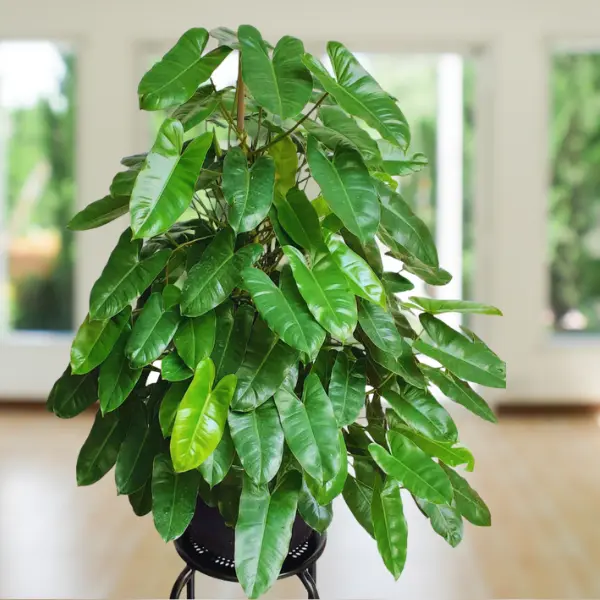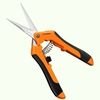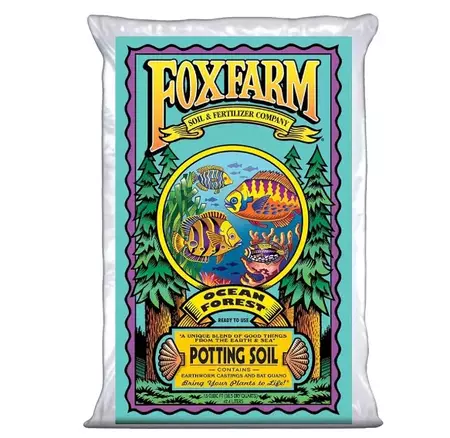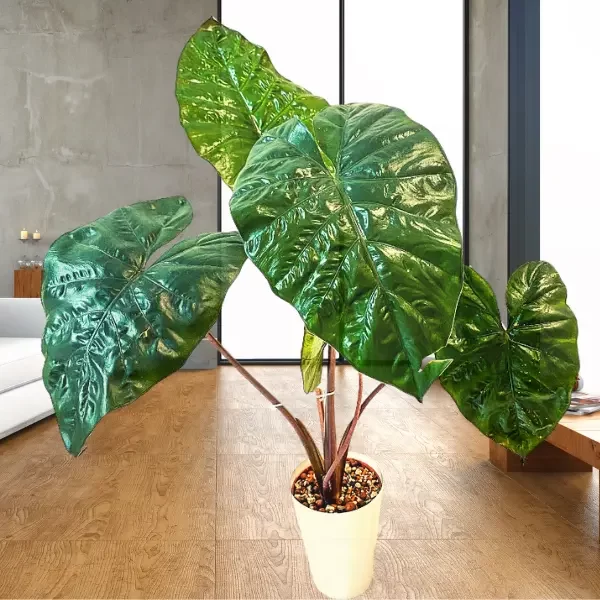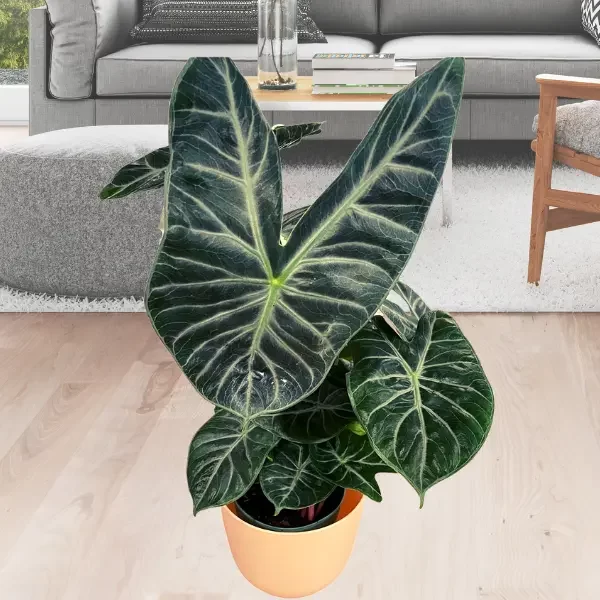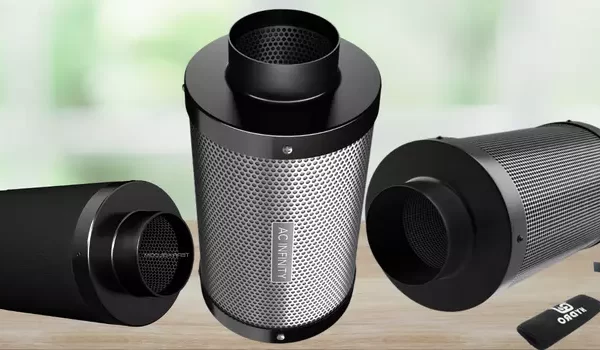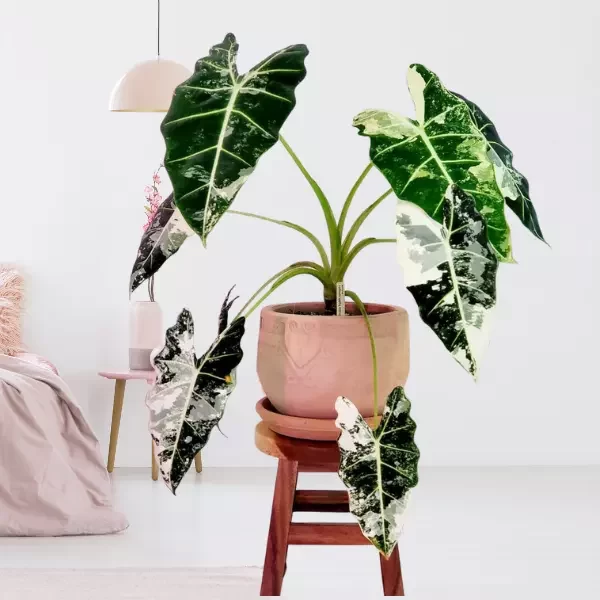Philodendron Burle Marx holds a unique and distinguished position in the world of houseplants. The most notable feature of the Philodendron Burle Marx is its large, glossy leaves, which come in heart-shaped or arrow-shaped variations. These leaves are adorned with prominent veins, contributing to their distinctive appearance. While typically green, some cultivars exhibit variegated patterns with white or yellow accents.
Whether grown in a compact space or as part of a lush tropical setting, this Philodendron excels in creating a vibrant and inviting atmosphere. Additionally, like other Philodendrons, it serves the dual purpose of enhancing your decor while purifying the air by removing harmful chemicals.
Closely-Related Allied Species: Philodendron Verrucosum, Philodendron Mamei, Philodendron Moonlight, Philodendron Squamiferum, Philodendron Florida Ghost, Philodendron Moonlight, Philodendron Ring of Fire, Philodendron Scandens, Philodendron Brandtianum
Essential Products
Origin and Family
Belonging to the Araceae family, the Philodendron Burle Marx boasts many striking characteristics. This tropical gem originates from the rainforests of South America, where it thrives naturally. The name of this Philodendron pays homage to the renowned Brazilian architect Roberto Burle Marx. Roberto Burle Marx was a trailblazer in incorporating tropical plants into modern homes and landscapes, and this Philodendron is a testament to his legacy.
| Botanical Name | Philodendron imbe ‘Burle Marx’ |
| Family Name | Araceae |
| Other names | Philodendron Burle Marx |
| Plant Type | Perennial |
| Origin | South America |
| Color | Elongated Dark green leaves |
| Humidity | 40% to 50% |
| Temperature | 65°F to 85°F (18°C to 29°C) |
| Light Need | Bright indirect sunlight |
| Propagation | Stem cutting , Air layering |
| Soil type | Rich, quick-draining, loamy |
| Pests | Thrips and Mealybugs |
| Diseases | Leaf spot and Root rot |
| Toxicity | Toxic to humans and pets |
| Repotting | Once a year |
How to Care for Philodendron Burle Marx?
Growing Philodendron Burle Marx is a rewarding experience that can bring a touch of exotic elegance to your home. To cultivate this striking plant successfully, it’s crucial to acknowledge the potential for the Philodendron Burle Marx to grow to impressive heights, reaching up to 2 meters. Therefore, allocating sufficient space for the plant to flourish and exhibit its grandeur is essential.
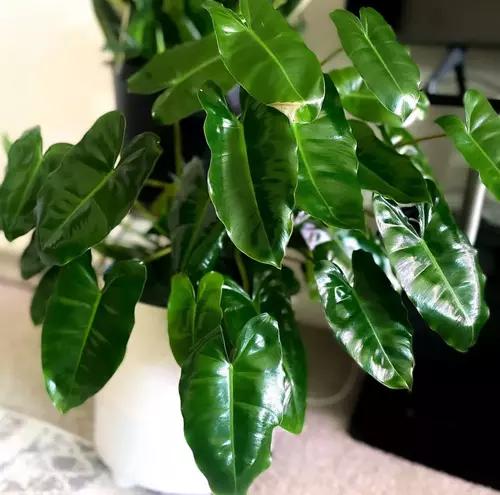
In addition to space considerations, providing the proper environmental conditions is vital for its well-being. This includes ensuring it receives ample indirect light and maintaining consistent watering practices. Striking a balance between not overwatering and underwatering is crucially important. Plus, well-draining soil will help prevent waterlogging and root rot.
Attention to ideal temperature and humidity levels further contributes to the plant’s prosperity. With these fundamental care guidelines, cultivating the Philodendron Burle Marx becomes a relatively straightforward endeavor, which allows you to enjoy its captivating presence in your living space. For detailed care requirements and tips, refer to the article below.

Bringing the P. Burle Marx to home
The new plant you bring home can be a carrier of pests and diseases. It is essential to quarantine your new plant for two weeks before introducing it to other indoor plants to protect them from contamination. In case your new plant is pest infested, there are great chances that your other plants will be infected if they come in contact. Especially spider mites and Meally bugs infestation spreads really quickly among the plants and becomes a bit of a challenge to control.
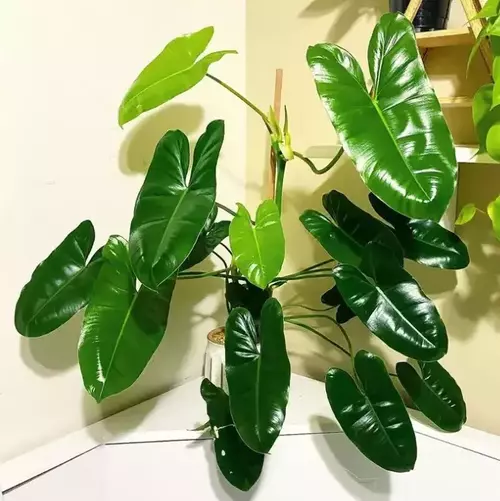
Carefully inspect the whole plant, especially the leaves, as pests feed on the leaves lower sides. Moreover, it is always a great practice to shower your plant when bringing it home to eliminate dust and any potential pests. For precautionary measures, apply neem oil or spray the pesticide on the leaf surface if you notice any pest invasion.
After two weeks, if the plant doesn’t show any pests and disease symptoms, place it in a bright, humid area among other plants to thrive happily indoors.

Watering
Proper watering is a fundamental aspect of caring for your Burle Marx. It has specific water requirements as a tropical plant that differs from many other houseplants. Instead of allowing the soil to dry out completely, it’s essential to maintain consistently moist soil to mimic the moisture-rich environment of its native habitat.
A fundamental guideline for watering this plant is when the top two inches of soil become dry, give your plant a good drink of water. For larger pots, you should observe the top half of the soil drying out before watering. To simplify this process and ensure accurate timing, using a simple tool like a chopstick can be incredibly effective. By inserting a chopstick into the soil, you can assess its moisture level. If the chopstick emerges without any soil adhering to the upper half, it’s an indicator that it’s time to water.
Overwatering and underwatering can both harm your plant. Overwatering leads to waterlogged soil, which causes root rot, while underwatering can lead to stress, wilting, and nutrient deficiencies. Striking a balance in watering is crucial to ensure healthy growth and prevent these adverse effects on your beloved plants.


Light
As a tropical plant, it thrives in bright conditions but dislikes direct sunlight as it may scorch the foliage. Therefore, it’s best to position it near a window with filtered or bright, indirect light. Positioning it near a north or east-facing window is ideal, as it allows the plant to receive gentle morning or late afternoon sunlight. This positioning ensures a balanced dose of light and creates an ambiance of natural beauty.
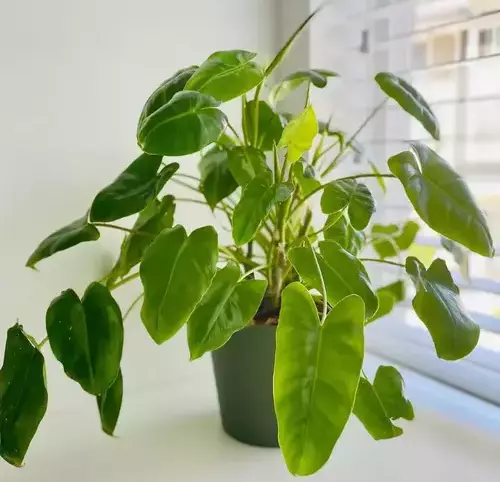
One of the advantages of the Philodendron Burle Marx is its tolerance for low-light conditions, which makes it an excellent choice for spaces with limited natural light, such as offices.
Exposing the Philodendron Burle Marx to excessive sunlight can lead to leaf burn, resulting in discoloration and damage to the leaves. If your plant is sitting in a south facing window, you might want to you use sheer curtains to prevent foliage burn from the high intensity noon sunlight.
Placing your Philodendron in a location that receives moderate to bright, indirect light will satisfy its light-loving tendencies, allowing it to bask in the luminous embrace it craves.
It is essential to shield its glossy leaves from direct sunlight. Prolonged exposure to intense rays can scorch its delicate foliage, causing unsightly burns and irreversible damage. The leaves may display brown patches or develop a bleached appearance, signaling that the plant receives more light than it can bear.
Additionally, wilting, curling, or drying of leaves can occur due to excessive light, causing stress to the plant. These signs serve as a warning call to reevaluate the light conditions and adjust accordingly.
Conversely, lacking light can hinder the plant’s growth potential and compromise its visual allure. Insufficient light may lead to leggy, elongated stems as the plant stretches toward the nearest light source to satisfy its desire for brightness. The leaves may lose their luster, becoming smaller in size. You can supplement your plant with some grow lights for plant to photosynthesize effectively.

Humidity
Maintaining suitable environmental conditions for your Burle Marx Philodendron is essential for overall health and vitality. While many houseplants, including the Burle Marx, originate from tropical regions with high humidity, they often adapt well to the typical conditions found in most homes. The ideal humidity range for this plant falls between 25% to 50%. While it appreciates moderate humidity, it isn’t overly sensitive and can thrive in standard home humidity levels.
If there are low moisture levels, you can elevate it by
Grouping: Place the Philodendron near other plants. As they release moisture through transpiration, it will raise the humidity in their vicinity.
Tray of water: Place a tray filled with water and pebbles near the plant. As the water evaporates, it increases the humidity around the plant.
Humidifier: Use a room humidifier to maintain consistent humidity levels in the area where your plant is located.
However, you might hear about misting your plant to increase the humidity, but in my experience, it’s not practical. Let’s face it, firstly, misting your plant will increase the humidity temporarily, and secondly, it’s a hectic job to mist a large group of plants frequently. I would highly suggest investing in a good plant humidifier if you own some tropical plants.
Bathroom or kitchen placement: These rooms tend to have higher natural humidity, so placing your Philodendron in these areas can be beneficial.
Terrarium or cloche: Consider placing your plant in a closed terrarium or under a glass cloche to create a microenvironment with higher humidity.
Temperature
In terms of temperature, keeping your Burle Marx Philodendron within the range of 65ºF (18ºC) to 75ºF (24ºC) is crucial. Given its tropical origins, this plant is not frost-tolerant and cannot withstand very low temperatures. Maintaining a consistent and suitable temperature range helps ensure that the plant remains healthy and doesn’t experience temperature-related stress.
Sudden temperature variations can stress this Philodendron, challenging its overall health. Swift shifts from warm to cold or vice versa can cause shock, leading to leaf drop, wilting, or even plant death. Therefore, gradual adjustment to changing temperatures, avoiding abrupt transitions, and shielding the plant from extreme fluctuations are crucial to maintaining its balance.
To sum up, your Burle Marx Philodendron’s ability to adapt to various humidity and temperature conditions makes it a versatile and resilient houseplant. You can create an optimal setting for its growth and well-being by providing a balanced environment within these recommended ranges.

Potting Soil
Creating an ideal potting mix is crucial for promoting the healthy growth of your indoor plants. The potting medium’s composition plays a significant role in guaranteeing that your plant receives the right balance of moisture, aeration, and nutrients. To achieve this balance, it’s essential to select appropriate ingredients in varying proportions to design a customized mix tailored to your plant’s specific needs.
A well-draining and aerated potting mix is especially crucial in preventing overwatering, which is a common issue that can lead to root rot, fungal diseases, and pest infestations. You can make an ideal potting mix for Philodendron Burle Marx by incorporating the following ingredients
- Pumice
- Coconut chips
- Perlite
- Pine bark
- Coco peat
- Vermiculite
- Sand
- Horticultural charcoal
Pumice, perlite, and sand are lightweight materials that help improve aeration within the mix, allowing excess water to drain quickly. Pine bark adds texture and aids in preventing compaction, ensuring adequate air circulation in the root zone. Coconut chips, coco peat, and vermiculite offer moisture retention, and horticultural charcoal helps maintain a healthy microbial balance in the soil by preventing mold and bacteria growth.
The key objective is to create a potting mix that mimics the plant’s natural habitat, thereby reducing the risk of overwatering and associated problems like root rot. A well-balanced mix, as described, minimizes these issues while promoting optimal plant health, enabling your indoor plants to thrive and flourish.
Besides that, you can also choose from our recommended potting mixes available in the market, such as:

Repotting
Repotting your Burle Marx is a straightforward process that can benefit your plant in several ways. It’s essential to repot when the current pot becomes too small to allow for healthy growth or when you want to provide fresh nutrients to your plant. Additionally, repotting enables you to remove old compacted soil and replace it with well-draining soil rich in oxygen.
The best time to repot your Philodendron Burle Marx is in the spring, as this is when the plant typically experiences increased growth. To begin the repotting process, follow these steps:
- Prepare a suitable potting mix using the ingredients mentioned above.
- Select a pot that is one size larger than the current one to allow for adequate space for root growth.
- Carefully pull the soil away from the edges of the current pot using a spatula or root rake, making it easier to remove the plant.
- Gently remove the plant from the pot and loosen the rootball slightly.
- Examine the roots for any signs of disease or rot, and trim away any diseased, soft, smelly, or mushy roots.
- Fill the new pot with soil to about one-third of its depth, then place the plant in the center and fill the remaining space with soil.
- Firmly press the soil around the plant to ensure there are no air pockets, and then water the plant thoroughly.
- Position your Philodendron Burle Marx in front of a window with medium indirect light to help it acclimate to its new pot.
By following these steps, you can help your Burle Marx thrive in its new pot, fostering healthy growth and maintaining its beautiful appearance in your indoor garden.

Philodendron Burle Marx Propagation
Burle Marx can easily be propagated via stem cuttings and air layering with 99% success rate.
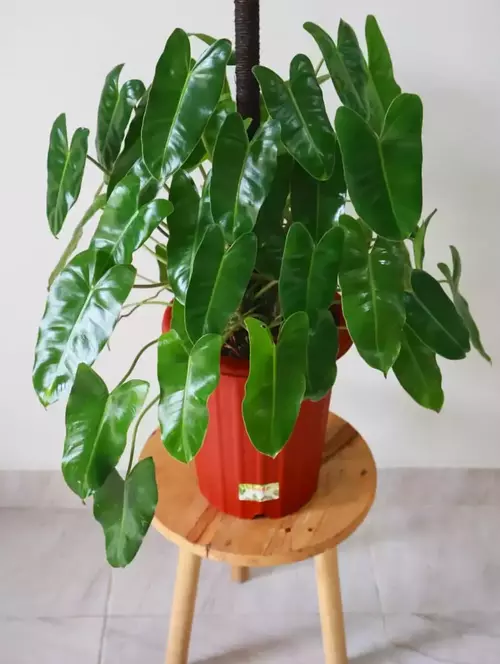
Stem Cutting Propagation
I prefer stem-cutting propagation for this climbing philodendron as this is simple and has a high success rate. As the leaves are enormous, single-node cuts are just fine for propagation.
Follow a step-by-step guide for Philodendrons Burle Marx propagation via stem cutting.
Propagation in Water
You can put your Philodendron Burle Marx cutting in water to propagate if it has minimal aerial roots. However the cutting takes relatively long time to root in water.
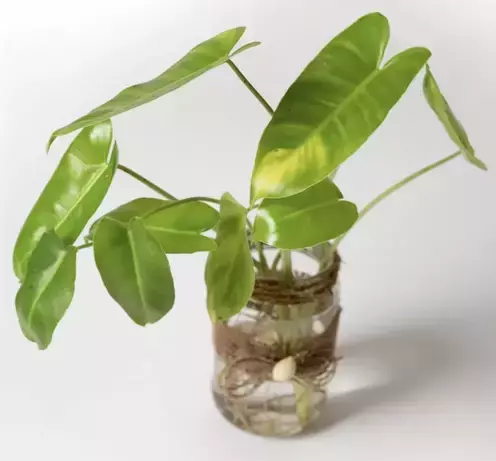
Propagation in Sphagnum Moss and Potting soil
You can also use sphagnum moss and aroid potting mix for rooting your cuttings. I prefer using sphagnum moss for cuttings that have a little bit of roots and potting mix directly if they already have a lot of roots.
Before putting your cuttings in sphagnum moss or potting mix, you might need to seal the edge of your cutting by applying cinnamon powder, anti-fungal powder, or activated charcoal to prevent rotting.
Choose a small plastic pot, put the Burle Marx’s cutting in it, and cover the node with a little potting mix. You don’t want to bury the node too much in the potting mix as it will increase the incidence of over-watering.
Air Layering Propagation
Philodendron Burle Marx grows aerial roots along its stem and can be propagated using air layering method. However, this is less common method but possible if you don’t want to cut your plant.

Fertilizing
Fertilizing your Burle Marx Philodendron is an essential aspect of its care, but it should be done thoughtfully to avoid potential issues. While it’s true that frequent repotting can provide fresh nutrients to the plant, some enthusiasts prefer to complement this with fertilization to ensure optimal growth.
When choosing a fertilizer, it’s wise to select one with a balanced N-P-K ratio, which refers to the nutrient content of nitrogen (N), phosphorus (P), and potassium (K). The Sill fertilizer with a ratio of 9-3-6 is an excellent choice as it provides the necessary nutrients for healthy growth. Following the recommended dosage on the package is crucial to prevent over-fertilization, which can be harmful to your plant.
If you are new to plant parenting I highly recommend trying Miracle-Grow Indoor Plant Food Spikes. These pellets are really easy to use and will not burn any foliage of your plant.
Here are some good fertilizers for your Philodendron available on the market:
- Philodendron Plant Food, Indoor Plant Food Liquid Fertilizer
- Liqui-Dirt Nano Powder All-Purpose Organic Plant Food
- Osmocote Smart-Release Plant Food
The timing of fertilization is another critical consideration. Rather than adhering strictly to a particular season, it’s best to observe your plant’s growth patterns. Fertilize your Philodendron Burle Marx when it’s actively growing, regardless of the time of year. Fertilizing during periods of inactivity can result in an accumulation of nutrients in the soil which increases the risk of root burn and other issues.
Finally, it’s important to read and follow the instructions on the fertilizer package carefully. Different fertilizers have different instructions, so use the correct amount and feed your plant the right amount at the right frequency.

Pruning and Maintenance
Pruning the Burle Marx is a relatively straightforward and infrequent task. Typically, this plant doesn’t require much pruning, and any cutting is primarily done to maintain its overall health and appearance. The primary reason for pruning your Burle Marx is to eliminate dead or damaged leaves, which can be done whenever you notice them throughout the year.
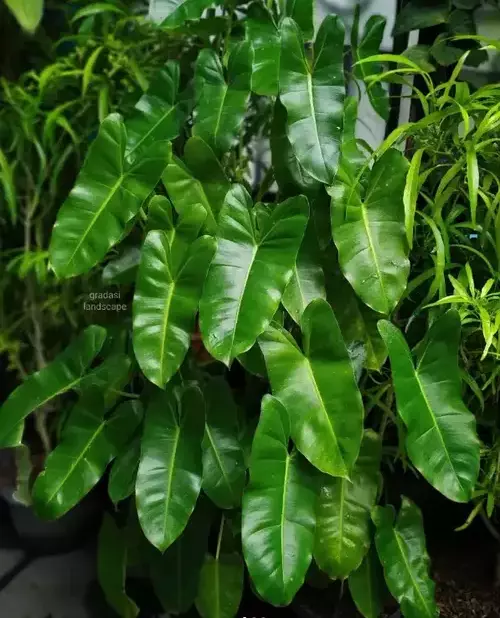
In most cases, there’s no need to trim this philodendron for size, as it naturally maintains a compact growth habit. However, if you find it necessary to manage its spread, you can do so by pruning it above a leaf node on the stems. This selective trimming can help control its upward or lateral growth and maintain the desired shape.
Whenever you engage in pruning, ensure your cutting tools, such as scissors or knives, are sterilized to prevent the introduction of any infections. Overall, the Philodendron Burle Marx’s pruning requirements are minimal, maintaining its vitality and aesthetic appeal by removing damaged or unwanted growth.
During maintenance, it is beneficial to check the plant for any signs and symptoms of pests, diseases, or nutrient deficiencies. Vigilance allows for early detection and prompt intervention, safeguarding the plant’s well-being.
As a climbing plant, the Burle Marx may require occasional support and training to prevent unruly growth. Gentle guiding of the vines along a trellis or support structure encourages a more orderly growth pattern. This practice enhances the plant’s visual appeal, promotes better airflow, and reduces the risk of entanglement or damage.

Toxicity
Philodendron Burle Marx poses a toxicity risk to both humans and pets due to the presence of calcium oxalate crystals in its sap. In humans, contact with these crystals can lead to irritation of the lips, mouth, and tongue. It potentially can cause breathing difficulties due to throat swelling.
For pets, ingestion of the plant may result in mouth irritation, including swelling of the mouth, tongue, and lips, accompanied by symptoms such as excessive drooling, vomiting, and difficulty swallowing. To prevent any potential harm, it is essential to exercise caution and keep this plant out of reach of curious children and pets.

Diseases & Pests
The Philodendron Burle Marx is not immune to the challenges posed by diseases, pests, and other common problems. Let us delve into these challenges and explore strategies for countering them effectively.
Diseases
The Philodendron Burle Marx may encounter certain diseases, primarily fungal, which can hinder its growth and vitality. Some common diseases include:
Root Rot
Root rot is a common problem that can affect your Philodendron Burle Marx if the soil remains consistently too wet. It’s caused by various types of fungi that thrive in overly moist conditions. Signs of root rot include yellowing leaves, wilting, and a foul, musty odor from the soil. When you check the roots, they may appear brown, mushy, and unhealthy.
Causes: Overwatering, poor soil drainage, or using a pot without proper drainage holes can lead to root rot.
Treatment: To treat root rot, you should remove the plant from the affected soil, trim away any diseased roots, and let the plant dry for a few days. Repot it in fresh, well-draining soil in a pot with drainage holes, and adjust your watering habits to prevent further issues.
Leaf Spot
Leaf spot is a fungal disease that can affect your Burle Marx Philodendron. It appears as small, dark brown or black spots on the leaves. As the disease progresses, the spots may enlarge and merge, causing leaf yellowing and drop. Humid conditions and poor air circulation can encourage leaf spot development.
Causes: Leaf spot is typically caused by excess moisture on the leaves, often due to overwatering or overhead watering.
Treatment: To treat leaf spot, prune and dispose of the affected leaves, improve air circulation around the plant, and avoid overhead watering. You can also use a fungicidal spray if the problem persists.
Pests
The Philodendron Burle Marx can fall victim to several common pests, including:
Mealybugs
Mealybugs are common indoor plant pests that can affect your Philodendron. They are small, soft-bodied insects covered in a white, waxy substance. Signs of mealybug infestation include white, cottony clusters on the leaves and stems, as well as stunted growth and yellowing foliage. These pests feed on the plant’s sap and weaken it over time.
Causes: Mealybugs are typically introduced to your plant through contaminated soil or nearby infested plants. They thrive in high humidity conditions.
Treatment: To get rid of mealybugs, you can use a solution of water and mild dish soap to wipe them off the plant. Neem oil or insecticidal soap can also be effective. Isolating the affected plant can prevent the spread of these pests.
Spider Mites
These tiny arachnids may appear as specks and create fine webbing on the plant. Regularly misting the foliage, ensuring adequate humidity, and using insecticidal soap can help control spider mites.
Thrips
Thrips are tiny, slender insects that can damage your Burle Marx. Signs of thrips infestation include silvery streaks on the leaves, distorted growth, and black specks of their excrement. Thrips feed on plant juices by puncturing the leaves and sucking out the contents.
Causes: Thrips are often brought into your home via contaminated soil, new plants, or open windows and doors.
Treatment: You can use neem oil or insecticidal soap to control thrip infestations. Maintaining good hygiene and regularly inspecting your plants can help prevent these pests.
Common Problems
Apart from pests and diseases, the Philodendron Burle Marx can encounter additional challenges.
Overwatering
Overwatering your Philodendron Burle Marx is a common issue. It leads to soggy soil, which can cause root rot. Signs of overwatering include yellowing leaves, wilting, and a foul odor from the soil. The soil remains consistently wet, and the roots may appear brown or mushy.
Causes: Overwatering typically results from excessive watering frequency or using a pot without proper drainage holes.
Underwatering
Underwatering is another concern, where the plant doesn’t receive enough moisture. Symptoms include drooping leaves, browning leaf edges, and dry, crisp leaves. The soil may become very dry and hard to the touch.
Causes: Underwatering occurs when you don’t water your plant as frequently as it needs, especially during hot or dry periods.
Overfertilization
Overfertilizing your Philodendron can lead to nutrient imbalances and various issues. Symptoms include browning leaf edges, leaf burn, or fertilizer salt buildup on the soil surface. Your plant may not grow properly, and you might notice a decrease in overall health.
Causes: Overfertilization happens when you apply too much fertilizer, use a fertilizer with a high concentration, or fertilize too frequently. Always follow recommended dosages and schedules for fertilizing.

Common Queries
Can Philodendron Burle Marx take direct sunlight?
Philodendron Burle Marx prefers bright, indirect light. Direct sunlight can scorch its leaves which can cause damage. It’s best to provide filtered or diffused light to maintain the plant’s health.
What is the best soil for Burle Marx?
The ideal soil for Philodendron Burle Marx should be well-draining and aerated to prevent overwatering. A mix consisting of components like all-purpose soil, perlite, bark, or other amendments such as pumice or sand, can create a suitable potting medium. This mixture helps maintain good aeration and drainage, reducing the risk of root rot and other issues.
Is a philodendron Burle Marx a crawler or climber?
Philodendron Burle Marx is primarily a crawler, but it can exhibit some climbing tendencies with proper support. While it won’t climb tall structures or trellises like some other philodendron varieties, it may spread along the ground or nearby surfaces if not provided with support.
Does Burle Marx grow fast?
Philodendron Burle Marx is considered a moderate grower. It won’t grow as fast as some other philodendron varieties, but it can still exhibit steady growth under optimal conditions.
How often should you water Philodendron Burle Marx?
You should water Philodendron Burle Marx when the top one to two inches of soil is dry. The frequency of watering depends on various factors, including the environmental conditions and the size of the pot. It’s essential to check the moisture levels in the soil and avoid overwatering, as it is susceptible to root rot.

Conclusion
Philodendron Burle Marx is an excellent choice for those seeking a low-maintenance indoor plant that can instantly bring an exotic touch to their living space. With its beautiful, large, glossy leaves and unique foliage patterns, this philodendron stands out as a vibrant and eye-catching addition to any indoor garden.
Its adaptability to various light conditions and relatively straightforward care requirements making it an ideal choice for both beginners and experienced plant enthusiasts. The rapid growth of Philodendron Burle Marx means you can enjoy a lush and tropical atmosphere in your home without a long wait, and its air-purifying qualities contribute to a healthier indoor environment.
Related Posts
Alocasia Sarawakensis Yucatan Princess Care
Dear Gardeners!! If you want to add a dramatic look to your home, there is no plant better than exotic and bold Alocasia Yucatan princess. This beautiful plant flaunts large dark green crinkled glossy leaves with brown underside and velvety…
Alocasia Ivory Coast Care and Propagation Guide
Alocasia Ivory Coast is a striking houseplant featuring impressive silvery webbed flat leaves. The striking contrast between fat, rounded, dark green arrow-shaped leaves and silver veins coupled with beautiful pink petioles make this plant an exceptional exquisiteness to stand out.…
Best Carbon Filter for Grow Room and Grow Tents
Once you set up your grow room or tent and start cultivating some plants and weeds, you will begin sensing some sharp pungent smells around your household. Indoor plant cultivation, including cannabis, requires the use of fertilizers, nutrients, and pesticides,…
Alocasia Sanderiana | Kris Plant Care and Propagation Guide
Hello, plant parents! Today is about one of my favorite plant the Alocasia Sanderiana which you would find in collections of plant enthusiasts and is commonly mistaken by Alocasia Polly, Amazonica and Bambino. Alocasia Sanderiana is one of the rarest…
Alocasia Frydek Variegated Care and Propagation Guide
Alocasia Frydek Variegated is the most exotic, ultra-rare, and magnificent variety of the Araceae family, featuring an exquisite, stunning, luxurious velvety appearance that would leave anyone to fall in love with this beauty. This plant exhibits soft, velvety broad heart-shaped…

